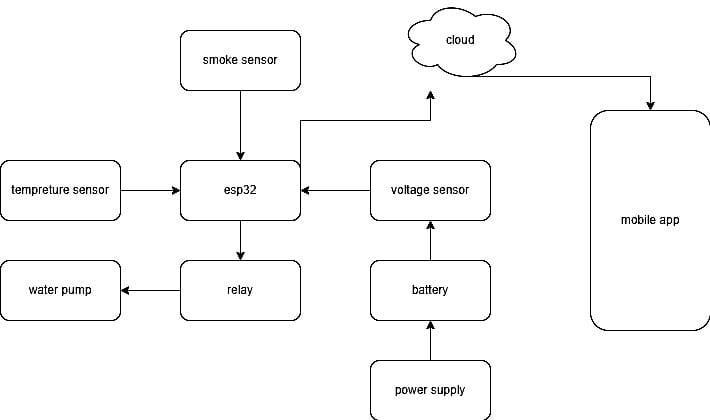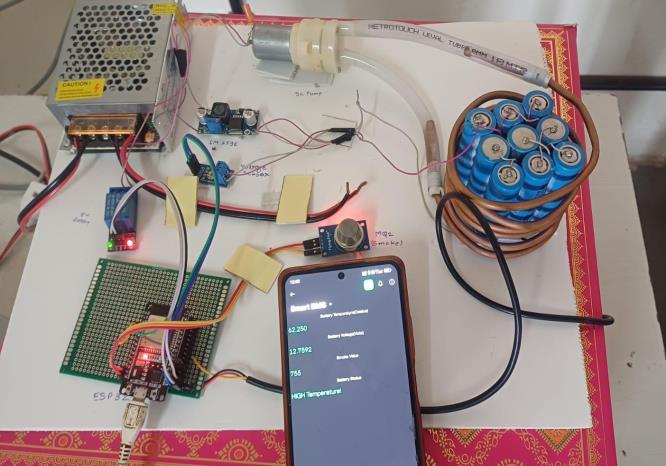
International Research Journal of Engineering and Technology (IRJET) e-ISSN: 2395-0056
Volume: 12 Issue: 02 | Feb 2025 www.irjet.net p-ISSN: 2395-0072


International Research Journal of Engineering and Technology (IRJET) e-ISSN: 2395-0056
Volume: 12 Issue: 02 | Feb 2025 www.irjet.net p-ISSN: 2395-0072
Miss. Mrunali H. Bansode1 , Prof. Mallad H. Mallikarjun 2 , Prof. Patil V. Jagannath 3
1Research Scholar at Fabtech Technical Campus, College of Engineering and Research, Sangola, Maharashtra, India.
2H.O.D. & Assistant Professor Electrical Dept., Fabtech Technical Campus, College of Engineering and Research, Sangola, Maharashtra, India.
3Assistant Professor Electrical Dept., Fabtech Technical Campus, College of Engineering and Research, Sangola, Maharashtra, India.
Abstract - In this study, the increasing use of lithium-ion batteries in various applications demands efficient thermal management to ensure safety and longevity. This project introduces an IoT-based battery temperature management system utilizing an ESP32 microcontroller to monitor and regulate temperature. A temperature sensor detects overheating, triggeringawater-cooledmechanismviaarelaycontrolled pump to dissipate heat effectively. Additionally, a voltage sensor provides insights into battery health, while a smoke sensor detects potential hazards. Real-time data is transmitted to the Blynk IoT platform, enabling remote monitoring and instant alerts. This system enhances battery safety, efficiency, and lifespan, making it ideal forapplications like consumer electronics and electric vehicles.
Key Words: BatteryManagementSystem(BMS),IoT-based Monitoring, Lithium-ion Battery Safety, Thermal Management, Real-time Temperature Monitoring, Energy StorageSafety,BlynkApp
Lithium-ion batteries are essential in modern technology, powering everything from smartphones and laptops to electric vehicles and medical devices. Their high energy density,lightweightdesign,andrechargeabilitymakethem ideal for various applications. However, extreme temperatures can significantly impact their efficiency, lifespan,andsafety.Coldtemperaturesreducepoweroutput, while excessive heat accelerates battery degradation. In severe cases, overheating can lead to thermal runaway, a dangerousconditionwherethebattery'stemperaturerises uncontrollably,potentiallycausingfirehazards due tothe releaseofflammableelectrolytes.Tomitigatetheserisks,an IoT-based battery temperature management system provides an intelligent solution. This system, built around theESP32microcontroller, continuouslymonitorsbattery temperature using sensors and takes proactive cooling measures when necessary. If the battery overheats, the systemactivatesawater-cooledmechanismthatefficiently dissipates excess heat. Additionally, real-time data on temperature and voltage is transmitted to a cloud-based platform like Blynk IoT, allowing users to remotely track
battery health through a mobile app. In case of extreme overheating or potential hazards like smoke detection, instantalertsaresenttousers,enablingpromptaction.By integrating real-time monitoring, automated cooling, and remote alerts, this smart battery management system enhances both the safety and lifespan of lithium-ion batteries. This innovation is especially valuable in electric vehicles,renewableenergystorage,industrialapplications, and consumer electronics, ensuring optimal battery performanceandreducingrisksassociatedwithoverheating
to develop a robust IoT-based system using an ESP32 microcontrollerandaclosed-loopwatercoolingmechanism tomonitorandregulatethetemperatureofabatterypack, ensuring optimal performance, longevity, and real-time remotemonitoringviatheBlynkIoTplatform
1. Continuously monitor battery temperature using a high-accuracytemperaturesensor.
2. DisplaytemperatureandvoltagereadingsonauserfriendlyBlynkappinterface.
3. Employawater-coolingsystem,activatedbyarelaycontrolled water pump, to maintain optimal battery temperature.
4. Trigger alerts via the Blynk app if the battery temperatureexceedsapredefinedthreshold,indicating potentialoverheating.
5. Optionally, integrate a smoke sensor to provide an additionallayerofsafetybysendingalertsincaseof smoke detection, potentially signifying a battery thermalrunawayevent.
6. Utilize a lithium-ion battery for its inherent safety characteristics,longlifespan,andthermalstability.
TheliteraturereviewhighlightsthecriticalroleofIoT-based BatteryManagementSystems(BMS)inenhancingthesafety, efficiency,andlifespanoflithium-ionbatteries,particularlyin

International Research Journal of Engineering and Technology (IRJET) e-ISSN: 2395-0056
Volume: 12 Issue: 02 | Feb 2025 www.irjet.net p-ISSN: 2395-0072
electricvehicles(EVs)andenergystoragesystems.Studies emphasize real-time monitoring of key parameters like temperature, voltage, and state of charge (SoC) using platformslikeBlynkandMQTT,enablingremoteaccessibility andautomation.Variouscoolingtechniques,includingwatercoolingsystems,havebeenexploredtopreventoverheating and degradation. Additionally, balancing mechanisms and safety features such as fire and smoke detection further improve battery reliability. The integration of ESP32, Arduino, and Raspberry Pi enhances decision-making, making IoT-enabled BMS solutions crucial for optimizing batteryperformanceandlongevity
Contributionsofresearchersarepresentedasfollows,
Rohan Nandi, Abhishek Verma, Kunal Dr. H.P Singh (2023) [1] ThestudyexaminedaBatteryManagementSystem (BMS)foranelectricbikeandexploredwaystoimproveits quality and reliability. It focused on understanding the battery management system, its applications, and incorporatingnewsafetyandcoolingfeaturestoenhanceits robustnessanddependability.
SamyakNagrale,AnkitWaghmare,TanmaySahare,Achal Nagwanshi, Ishika Sakhale, Dr. Jyoti Sathe (2023) [2] The casestudyexaminedthegrowthofelectricvehiclesinrecent years due to their zero emissions of harmful gases and efficient energy usage. However, the performance of an electricvehicledependsonitsBatteryManagementSystem (BMS).ThegoalofthispaperistodesignanArduino-based BMS to monitor and control the charging and discharging processesofthebattery.TheBMStracksthestateofcharge, temperature,andvoltageofeachcellinthebatterypack.It utilizesvarioussensorsandindicatorstoprovideinformation aboutbatterylifeandperformance.TheproposedBMScan enhancetheperformanceandlifespanofthebatterypack, makingelectricvehiclesamorereliableandefficientmodeof transportation.
Akanksha Chouhan, Akshay Deshmukh, Sandesh Somware, Ujjain Jori(2021) [3] Thecasestudydesigneda smart building automation system using Arduino and Arduino software for programming. The system supports varioussensorsandtheirfunctionalitieswhilemaintaininga practical and cost-effective configuration. The design and implementation of a Building Management System (BMS) contribute to the development of various green projects, utilizingadvancedtechnologytocreateasuperiorlivingand working space. This system helps reduce human effort by automating key functions. The key features of our project include gate opening and closing via an RFID module, commonarealightingcontrol,dooroperationusingakeypad, and fire detection with alerts sent to the main system. All hardwaresensorsandArduinocomponentsareintegrated into anoptimized demonstrationmodel to test the system andpresentitsfunctionalityinrealtime.Withthismodel,the smartBMSenvironmentiseffectivelyvisualized,makingits functions easy tounderstand. The BMS isa reliable circuit
that automates and controls various integrated systems, enhancingefficiencyandconvenience.
Ashutosh Patel, Shriparno Dey, Akshat Ashish Choudhury,HarrisB.Mathews [4] thecasestudyexamined the use of Li-ion batteries in electric vehicles and energy storageduetotheirlowself-dischargerate,longcyclelife, highenergydensity,andwideoperatingtemperaturerange. ToensuresafetyandpropermanagementofLi-ionbattery packs,aBatteryManagementSystem(BMS)isrequired.The balancingprocessiscrucialformaintainingbatterylifespan andprotectingbatterycellsina seriesconnection.Passive balancing is commonly used in BMS due to its costeffectivenessandsimplicity.Itutilizespassivecomponents suchasresistorsordiodestodischargeexcesschargefrom thebattery.ABMSisdesignedusinghardwarecomponents suchasresistors,diodes,transistors,andLEDs.Inthisstudy, aMOSFETisusedforswitchingvoltagetobalancethecells, while a diode and resistor help discharge the battery. The experimental platform includes functionalities such as voltage and current measurements, State of Charge (SOC) calculation,cellbalancing,andbatterycharging.
Muhammad Mansab Uzair,Salah Yacoub AlKafrawi,Karam Manaf Al-Janadi,Ibrahim Abdulrahman Al-Bulushi [5] ThecasestudydesignedanInternetofThings (IoT)-based Building Management System (BMS) for monitoring, control, and energy management in buildings, aiming to optimize energy utilization efficiently. Existing systemsprimarilyfocusonmonitoringvariousparameters but offer limited control and automation functions. Additionally,theylackautomaticdecision-making,advanced safety management, and resource tracking capabilities. In contrast, the proposed system provides a comprehensive solutionformonitoring,controlling,andmakingautomatic decisions regarding various environmental and electrical parameters in buildings such as temperature, humidity, dust levels, and voltage using a low-cost wireless sensor network (WSN). The architecture of the proposed system consists of five layers and incorporates analog sensors connectedtoArduinoMega2560microcontrollersfordata collection, NodeMCU ESP8266 modules for wireless communication, and Raspberry Pi 4 microcomputers for decision-making. It also features a Node-RED dashboard, running locally on the Raspberry Pi 4, to provide a userfriendly interface. Furthermore, the system employs the Message Queuing Telemetry Transport (MQTT) communicationprotocoloverWi-Fi,relyingentirelyonlocal devices within the architecture, eliminating the need for cloudcomputingservices.Theproposedsystemsupportstwo differenttypesofautomation,enhancingbothefficiencyand reliabilityinbuildingmanagement.
Khaligh, S. Mishra, and L. Xu (2021) (6) The case study examinedanIoT-basedBatteryManagementSystem(BMS) for electric vehicles (EVs). It highlights the importance of monitoring temperature, voltage, and current to ensure optimalbatteryperformanceandsafety.

International Research Journal of Engineering and Technology (IRJET) e-ISSN: 2395-0056
Volume: 12 Issue: 02 | Feb 2025 www.irjet.net p-ISSN: 2395-0072
S. S. Patil, S. S. Bhongale, V. V. Wankhede, and P. P. Patil (2017) (7) The case study examined an IoT-based Battery Management System (BMS) that monitors battery voltage, current,temperature,andstateofhealth(SoH).Itemphasizes theroleofIoTinenhancingbatterysafetyandextendingits lifespan.
M. S. Hashmi, S. R. Bhat, and M. A. Rashid (2019) (8) The case study developed an IoT-based battery monitoring systemforEVs,focusingonkeyparameterssuchasvoltage, current, and temperature. It highlights the system's userfriendliness and the enhanced remote data accessibility enabledbyIoT.
A. A. Neha, R. P. Saini (2021) (9) Thecasestudyexamined various thermal management techniques for lithium-ion batteries,includingphasechangematerials,heatpipes,and liquidcooling.Itemphasizestheimportanceofmaintaining optimal battery temperatures to prevent degradation and ensuresafety.
H. Yang, Y. Jia (2020) (10) ThecasestudyexaminedanIoTbased Battery Management System (BMS) designed for electric vehicles, featuring real-time monitoring of battery parameterssuchastemperature,voltage,andcurrent.The systemutilizesESP32microcontrollersandBlynkforremote dataaccessandcontrol.
M. G. Prakash, S. Venkatesan (2021) (11) The case study designed a smart battery management system using IoT technologies, incorporating sensors for temperature and voltagemonitoring.Itemploysawater-coolingmechanism activatedbyarelayandcontrolledviaanIoTplatform
R. K. Singh, P. Kumar (12) The case study explored the integrationofIoTinthethermalmanagementoflithium-ion batteries, utilizing various sensors and a cooling system controlled by a microcontroller. It focuses on improving battery safety and performance through real-time monitoring.
Lithium-ionbatteries,whileofferinghighenergydensity,are susceptibletoperformancedegradationandsafetyhazards atextremetemperatures.Whenabatteryoverheats,itcan leadto:
Reduced Capacity and Lifespan: High temperaturesacceleratechemicalreactionswithin the battery, causing faster capacity loss and shorteningitsoveralllife.
Thermal Runaway: Inextremecases,overheating can trigger a chain reaction where the battery releases heat, further increasing its internal temperature, potentially leading to a fire or explosion.
Safety Concerns: Overheated batteries pose a significant safety risk, especially in applications where they are used in close proximity to people andproperty
Belowarefewgapswefoundinexistingsystem
Automatic Pump Flow Regulation:
Implement pulse-width modulation (PWM) to controlthewaterpump'sspeed,adjustingcooling basedontemperaturevariations.
Data Logging and Prediction:
Store historical temperature data in the cloud platformorlocalstorageforanalysis.
Utilizemachinelearningtopredictpotentialbattery overheatsandinitiatepreventiveactions.
Battery Health Monitoring:
Trackvoltageandtemperaturetrendstoestimate batteryhealthovertime.
Implementalgorithmstoidentifypotentialbattery degradation and suggest maintenance or replacement.
Security:
Usesecureauthenticationandencryptionmechanismsfor communication between the ESP32, cloud platform and Blynkapp
4.1 Hardware Assembly:
Connectthetemperaturesensortoananaloginput pinoftheESP32
Build a voltage divider circuit or use a dedicated voltage sensor to measure battery voltage and connectittoanotheranaloginputpin
InterfacethewaterpumpdriverwithaGPIOpinof theESP32tomanagethepump'soperation.Connect the pump driver's output to the pump's power supply.
(Optional) Connect the smoke sensor to a digital inputpin forsmokedetection.
Securely mount the temperature sensor near the battery to accurately capture its thermal state.Considerthermalpasteforoptimalcontact.

International Research Journal of Engineering and Technology (IRJET) e-ISSN: 2395-0056
Volume: 12 Issue: 02 | Feb 2025 www.irjet.net p-ISSN: 2395-0072
Crucially, ensure proper water circulation around the battery by creating a closed-loop cooling system:
Usetubingsuitableforthewaterflowrate andtemperaturerange.
Designinletsandoutletsforefficientwater flow.
Consider a reservoir for the water to preventconstantrefilling.
Power the ESP32 using a suitable power supply.
4.2 Software Development :-
ESP32 IDE Setup:
Install the Arduino IDE (https://www.arduino.cc/en/software)andaddtheESP32 board package following the official guide (https://docs.espressif.com/projects/espidf/en/stable/esp32/get-started/index.html).
Blynk Library Integration:
Include the Blynk library in your Arduino project and configureyourBlynkaccountwithauniqueauthentication token.
Sensor Reading and Calibration:
Readtemperatureandvoltagesensorvaluesusingrelevant functions (e.g.,analogRead()).Apply calibration factors if neededforaccuratereadings.
Water Pump Control Algorithm: Implement a control logic based on temperature readings.Forexample:
Iftemperature<safethreshold(e.g.,35°C):Turnoff pump.
If temperature > safe threshold and < critical threshold(e.g.,40°C):Turnonpumpatalowerduty cycle(e.g.,50%)forpartialcooling.
Iftemperature>criticalthreshold(e.g.,45°C):Turn on pump at full duty cycle (100%) for maximum cooling.
Consider hysteresis to prevent rapid on/off switchingofthepump:
Define a lower threshold (e.g.,33°C) to turn the pumpoffaftercooling.
Smoke Detection and Alerting: (Optional) If smoke is detected,send an immediate alert notificationtotheBlynkapp.
Data Visualization on Blynk App:
CreatevirtualgaugesorchartsintheBlynkappto displaybatterytemperatureandvoltagereadingsin real-time.
Implementvisualoraudiblealertsforoverheating andsmokedetection.
1. Blynk App Configuration:
CreateanewprojectintheBlynkappandenteryour authenticationtokenfromtheESP32code.
Add appropriate widgets (gauges,charts,buttons,notifications) to visualize sensordataandcontrolactions.
2. Testing and Deployment:
Thoroughlytestthesystembysimulatingdifferent temperature scenarios and verifying pump activation/deactivation,sensorreadings,andBlynk appfunctionality.
Ensure system safety by double-checking connectionsandwaterflow.
Oncesatisfied,deploythesystemin.
4.3
1. Sensor Data Acquisition: The ESP32 periodically reads data from the temperature and voltage sensors.
2. Temperature Control Logic: The ESP32 implementsacontrolalgorithmtodetermineifthe batterytemperatureexceedsapre-definedthreshold (e.g.,45°C).
3. Water Pump Control: Ifthetemperatureisabove thethreshold:
The ESP32 activates the relay, turning on thewaterpump.
Thewaterpumpcirculatescoolantthrough the tubes, drawing heat away from the battery.
4. Overheating Alert: If the temperature reaches a criticallevel(e.g.,55°C):
The ESP32 sends an immediate alert notification to the Blynk app, indicating potentialthermalrunaway.
(Optional) The ESP32 can also trigger an audiblealarmorshutdownthesystemfor safety.
5. Blynk App Interface: TheBlynkappdisplaysrealtimedata:
Batterytemperature
Batteryvoltage
Alertnotifications(iftriggered)
Optionally, the app can allow manual control of the water pump for user intervention

International Research Journal of Engineering and Technology (IRJET) e-ISSN: 2395-0056
Volume: 12 Issue: 02 | Feb 2025 www.irjet.net p-ISSN: 2395-0072
4.4 Block Diagram :

Figure 4.1: Block Diagram of Proposed System
4.5 Technical Specifications:
1. ESP32 Microcontroller
Description: A powerful microcontroller withbuilt-inWi-FiandBluetooth.
Specification:
Dual-core32-bitCPU
2.4GHzWi-Fi
Bluetooth4.2
OperatingVoltage:3.3V
2. DS18B20 Temperature Sensor
Description:Adigitaltemperaturesensor usedtomonitorthebatterytemperature.
Specification:
Temperature Range: -55°C to +125°C
Accuracy:±0.5°C
OperatingVoltage:3.0Vto5.5V
3. Voltage Sensor (e.g., Voltage Divider Circuit)
Description: A simple voltage divider to measurethebatteryvoltage.
Specification:
InputVoltage:Upto25V
Output Voltage: 0-3.3V (to match ESP32ADCinput)
4. Water Pump
Description: A small submersible water pumptocirculatewateraroundthebattery.
Specification:
OperatingVoltage:5Vor12V
FlowRate:Variable(e.g.,240L/H forasmallpump)
5. Relay Module
Description: Used to control the water pump.
Specification:
Operating Voltage: 3.3V or 5V (dependingonthemodule)
CurrentRating:10Aat250VACor 10Aat30VDC
6. MQ-2 Smoke Sensor
Description:Asensorto detectsmoke or gases that may indicate overheating or combustion.
Specification:
Detection Range: LPG, Smoke, Alcohol, Propane, Hydrogen, Methane,CO
OperatingVoltage:5V
Description:Thebatterybeingmonitored andmanaged.
Specification:
Voltage:3.7Vto4.2V(typicalfora singlecell)
Capacity:Varies(e.g.,2000mAhto 4000mAh)
8. Water Tubing
Description: Tubes to circulate water aroundthebatteryforcooling.
Specification:
Material:SiliconeorPVC
Diameter: Suitable for the water pump'sflowrate
9. Blynk App
Description:AnIoTplatformforreal-time monitoringandalerts.
Specification:
CompatiblewithiOSandAndroid
RequiresBlynkLibraryforESP32
5.1 Enhanced Battery Life:
Bymaintainingoptimaltemperature,thebattery'slifespan and performance are extended. This is because high temperaturescanacceleratedegradationprocesseswithin thebatterycells,leadingtoreducedcapacityandincreased risk of failure. By preventing excessive heat buildup, the systemhelpstopreservethebattery'shealthandprolongits servicelife

International Research Journal of Engineering and Technology (IRJET) e-ISSN: 2395-0056
Volume: 12 Issue: 02 | Feb 2025 www.irjet.net p-ISSN: 2395-0072
5.2 Improved Safety:
Early detection of overheating or fire hazards prevents potentialaccidents.Thesystem'scontinuousmonitoringand alert capabilities enable prompt intervention in case of abnormal conditions. This reduces the risk of thermal runaway, a dangerous condition that can lead to fires and explosions
5.3 Remote Monitoring:
Real-timedataandalertsenableproactivemaintenanceand troubleshooting. By remotely monitoring the battery's temperatureandvoltage,userscanidentifypotentialissues early on and take corrective actions. This minimizes downtimeandreducesthelikelihoodofunexpectedfailures.
5.4 Cost-Effective Solution:
Thesystemprovidesacost-effectivewaytomanagebattery temperature and ensure safety. Compared to traditional cooling methods, the water-based cooling system is relatively inexpensive to implement and maintain. Additionally, the IoT-based monitoring and control capabilities allow for efficient resource utilization and minimizeenergyconsumption

6. CONCLUSIONS
An IoT-based battery temperature management system employing an ESP32 and Blynk offers a proactive and efficientsolutionformaintainingoptimalbatteryhealthand safety. This system provides real-time monitoring, automated cooling control, and timely alerts, making it a valuable tool for applications that rely on lithium-ion batteries. By keeping battery temperatures within a safe range,thissystemcansignificantlyextendbatterylifespan, reducemaintenancecosts,andenhancetheoverallreliability andsafetyofbattery-poweredsystems.
The ability to remotely monitor and control the system throughtheBlynkappallowsforgreateruserconvenience and facilitates preventative maintenance strategies. For instance,userscanreceivealertswhenbatterytemperatures start to rise outside of normal operating ranges, enabling them to take corrective actions before a critical thermal event occurs. Additionally, the system's data logging capabilitiescanprovidevaluableinsightsintobatteryhealth trends over time, allowing for proactive maintenance schedulingandbatteryreplacementplanning.
Furthermore,thescalabilityofthisIoT-basedsystemmakes itsuitableforawiderangeofapplications.Byadjustingthe number and configuration of temperature sensors, water pumpcapacity,andcoolingloops,thesystemcanbeadapted toaccommodatebatterypacksofvarioussizesandpower requirements.Thisflexibilitymakesitidealforapplications ranging from portable electronics and electric vehicles to large-scale energy storage systems in renewable energy installationsandgridbalancingoperations
[1] Rohan Nandi, Abhishek Verma, Kunal Dr. H.P Singh “Design of Battery Management System (Bms) Of An ElectricBike”Volume:05,Issue:04,April-2023.
[2] Samyak Nagrale, Ankit Waghmare, Tanmay Sahare , Achal Nagwanshi , Ishika Sakhale , Dr. Jyoti Sathe “Arduino Based Battery Management System For ElectricVehicles”Vol-9Issue-22023.
[3] Akanksha Chouhan, Akshay Deshmukh, Sandesh Somware, Ujjain Jori “IoT based Smart Building ManagementSystemusingArduino”Volume:08Issue: 04|Apr2021www.irjet.net.
[4] Ashutosh Patel , Shriparno Dey , Akshat Ashish Choudhury,HarrisB.Mathews“BatteryManagement System using Passive Elements and Arduino” International Journal of Science and Research (IJSR) ISSN:2319-7064SJIF(2019):7.583.
[5] Muhammad Mansab Uzair, Salah Yacoub Al-Kafrawi, Karam Manaf Al-Janadi, Ibrahim Abdulrahman AlBulushi“ALow-CostIoTBasedBuildingsManagement System (BMS) Using Arduino Mega 2560 And RaspberryPi4ForSmartMonitoringandAutomation”.
[6] M. Naguib, P. Kollmeyer, and A. Emadi, “Lithium-ion battery pack robust state of charge estimation, cell inconsistency,andbalancing:Review,”IEEEAccess,vol. 9,pp.50570–50582,2021.
[7] K.Rumpf,M.Naumann,andA.Jossen,“Experimental investigation of parametric cell-to-cell variation and correlation based on 1100 commercial lithium-ion cells,”J.EnergyStorage,vol.14,pp.224–243,2017.

International Research Journal of Engineering and Technology (IRJET) e-ISSN: 2395-0056
Volume: 12 Issue: 02 | Feb 2025 www.irjet.net p-ISSN: 2395-0072
[8] A. Farjah and T. Ghanbari, “Early ageing detection of batterycellsinbatterymanagementsystem,”Electron. Lett., vol. 56, no. 12, pp. 616–619, 2020. [Online]. Available: https://ietresearch.onlinelibrary. wiley.com/doi/abs/10.1049/el.2019.3944.
[9] A. A. Neha, R. P. Saini, "Thermal management of lithium-ion batteries: A review," Renewable and SustainableEnergyReviews,2021.
[10] H.Yang,Y.Jia,"IoT-basedBatteryManagementSystem forElectricVehicles,"IEEEAccess,2020.
[11] M. G. Prakash, S. Venkatesan, "An IoT-enabled Smart Battery Management System for Electric Vehicles," JournalofPowerSources,2021.
[12] R. K. Singh, P. Kumar, "IoT-enabled Thermal Management of Lithium-ion Batteries," International JournalofEnergyResearch,2023.



Miss. Mrunali H Bansode
B.E.(Electrical),M.Tech(Electrical Engineering)(Pursuing) Research Scholar at Fabtech Technical Campus, College of Engineering and Research, Sangola, Maharashtra,IndiaandFacultyof N. B. Navale Sinhgad College of Engineering,Solapur,Maharashtra, India.
Prof. Mallad H Mallikarjun
WorkingasHeadofDepartment& Assistant Professor Electrical Engineering, Fabtech Technical Campus, College of Engineering and Research, Sangola, Maharashtra, India Having experienceofmorethan15years inteaching.
Prof. Patil V. Jagannath
WorkingasAssistantProfessorin Electrical Engineering, Fabtech Technical Campus, College of Engineering and Research, Sangola, Maharashtra, India Havingexperienceofmorethan15 yearsinteaching